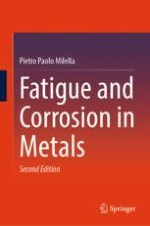In Sect.
1.2 we have introduced the Wöhler curve and the
S–N curve. Generally, they are considered to be the same thing, but they are not. The difference is in the life domain they cover. The Wöhler curve describes the fatigue behavior of a generic material from ¼ of a cycle to the fatigue limit,
σf, or, in case of no precise fatigue limit as for non-iron alloys (see Fig.
1.11), up to 10
8–10
9 or more cycles. The Wöhler curve, therefore, spans the entire fatigue life from low-cycle fatigue to high-cycle fatigue and beyond (see Fig.
1.10) covering all the three regions of fatigue. The
S–N curve, instead, describes the fatigue behavior of materials in the elastic domain or Region II, where the plastic contribution to stresses and strains is negligible. We may say, then, that the Wöhler curve is typically an
ε-N curve obtained under strain controlled conditions while the
S–N curve relates the stress amplitude
σa given by Eq. (
1.1), also indicated as
S, to the number
N of cycles to failure. When the stress amplitude is close to the fatigue limit,
σf, or knee of the
S–N curve the plastic component of deformation,
εp, becomes negligible or even vanishes. Fatigue is driven by the elastic component of the strain amplitude that is proportional to the stress amplitude through the Young’s modulus of the material. Therefore, as we approach the fatigue limit of the material,
σf, we can abandon strains as the controlling parameter and relate the fatigue life directly to the stress amplitude. The hysteresis loop disappears, as shown schematically in Fig.
1.10, because the material behaves almost completely elastically. In this area of elastic or quasi-elastic behavior any analytical approach to fatigue is generally indicated as stress-life method. Historically, it has been the first approach to fatigue and has been the standard design method for almost 100 years. Stress-life methods are generally used when the designer pursues a target of infinite-life or safe-stress design. When the stress amplitude reaches the elastic limit and strains have a significant plastic component the
S–N approach is no longer appropriate and a strain-based approach
ε-N becomes necessary, as it will be described in the next section.
